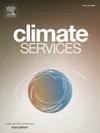基于标准化降水和潜在蒸散指数的毛乌素沙地干旱评价及发展趋势
IF 4
3区 环境科学与生态学
Q2 ENVIRONMENTAL SCIENCES
引用次数: 0
摘要
全球变暖导致干旱更加频繁。因此,为了了解干旱的发展特征,基于高分辨率气候数据,采用Mann-Kendall检验、经验正交函数分解和多阈值运算理论,对2002 - 2021年多尺度标准化降水指数(SPI)和标准化潜在蒸散指数(SPEI)的特征进行分析。基于CMIP6,通过多模式集合(MME)对2021 - 2040年不同排放情景下的干旱发展趋势进行了预测。结果表明,SPI和SPEI均能有效识别旱情。SPI短期尺度(1/3个月)对降水不足干旱的识别较为稳定,对高温驱动的突发性干旱更为敏感。这两个指标在长期尺度上(6/12个月)都能有效监测持续干旱。在低排放情景下(SSP126/245),干旱主要由降水变化主导。SPI和SPEI的结果比较一致,都可以用于监测。在高排放情景(SSP370/585)中,温度的升高加剧了蒸散作用。SPI能更准确地反映实际的干旱风险,而单纯依赖SPI可能会低估高温对干旱的强化作用。这些措施的全面实施将有效增强研究区应对日益严峻的干旱挑战的抵御能力。本文章由计算机程序翻译,如有差异,请以英文原文为准。
Drought assessment and development trend in Mu Us Sandy Land based on standardized precipitation and potential evapotranspiration index
Global warming leads to more frequent droughts. Therefore, in order to understand the development characteristics of drought, based on high-resolution climate data, the Mann-Kendall test, empirical orthogonal function decomposition and multi-threshold operation theory were adopted to analyze the characteristics of the multi-scale standardized precipitation index (SPI) and the standardized potential evapotranspiration index (SPEI) from 2002 to 2021. Based on CMIP6, the development trend of drought under different emission scenarios from 2021 to 2040 was predicted through multi-model ensemble (MME). The results show that both SPI and SPEI effectively identify the drought conditions in MUSL. The short-term scale (1/3 month) of SPI is stable in identifying drought with precipitation deficiency, and SPEI is more sensitive to sudden drought driven by high temperature. Both indicators on a long-term scale (6/12 months) can effectively monitor persistent drought. In the low-emission scenario (SSP126/245), drought is mainly dominated by precipitation changes. The results of SPI and SPEI are relatively consistent and both can be used for monitoring. In the high-emission scenario (SSP370/585), the increase in temperature intensifies evapotranspiration. SPEI can more accurately reflect the actual drought risk, while relying solely on SPI may underestimate the intensification effect of high temperature on drought. The comprehensive implementation of these measures will effectively enhance the resilience of the study area in responding to the increasingly severe drought challenges.
求助全文
通过发布文献求助,成功后即可免费获取论文全文。
去求助
来源期刊

Climate Services
Multiple-
CiteScore
5.30
自引率
15.60%
发文量
62
期刊介绍:
The journal Climate Services publishes research with a focus on science-based and user-specific climate information underpinning climate services, ultimately to assist society to adapt to climate change. Climate Services brings science and practice closer together. The journal addresses both researchers in the field of climate service research, and stakeholders and practitioners interested in or already applying climate services. It serves as a means of communication, dialogue and exchange between researchers and stakeholders. Climate services pioneers novel research areas that directly refer to how climate information can be applied in methodologies and tools for adaptation to climate change. It publishes best practice examples, case studies as well as theories, methods and data analysis with a clear connection to climate services. The focus of the published work is often multi-disciplinary, case-specific, tailored to specific sectors and strongly application-oriented. To offer a suitable outlet for such studies, Climate Services journal introduced a new section in the research article type. The research article contains a classical scientific part as well as a section with easily understandable practical implications for policy makers and practitioners. The journal''s focus is on the use and usability of climate information for adaptation purposes underpinning climate services.
 求助内容:
求助内容: 应助结果提醒方式:
应助结果提醒方式:


